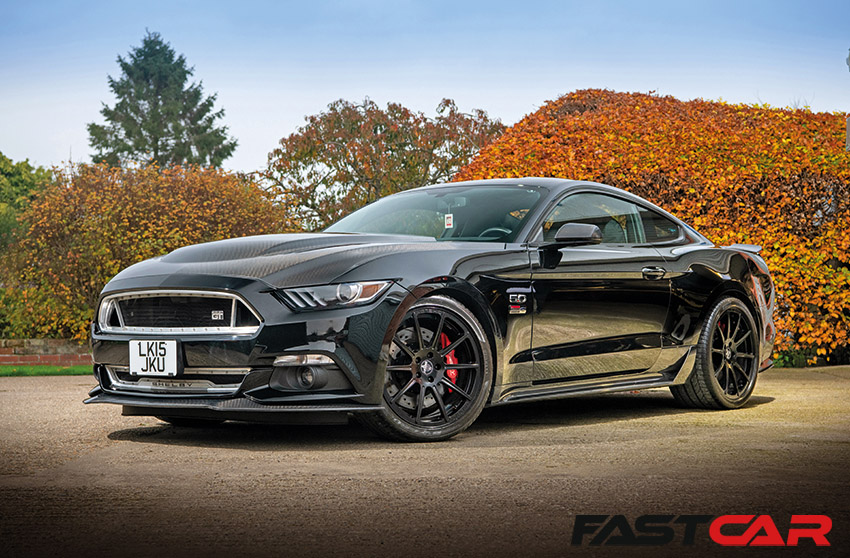With a 5.0-liter V8 engine, the Ford Mustang S550 GT wasn’t slow from the factory, can be oh-so-much more with a handful of tuning tweaks in the right places. Here’s how.
The sixth-generation Ford Mustang S550 has been with us for eight years, and like all Mustangs, it’s proving to be a tuning sensation with more and more quality upgrades appearing on the aftermarket. Yes, the lineup did include more frugal and more affordable engine configurations, but the one most car fans are interested in is the full-fat GT version. So, that’s the model we’ll focus on for this car tuning guide.
Unfiltered American Muscle
The GT follows the traditional Mustang format of being a big, brawny coupé with a rumbling V8. Only this time, the S550 also came in right-hand drive for the UK market, so British car fans could also enjoy the iconic Ford legend.
The 5.0-liter Coyote V8 found in the Mustang GT is a true gem. Packing over 400 horsepower as standard with rear-wheel drive, even a box-stock S550 is entertaining. But it has so much more to give if you tickle it in the right places. Power can be taken to crazy levels (even on stock internals); the chassis can be tuned to suit the road, track or drag strip (or a combination of all three); and there are so many styling parts available (from the aftermarket and limited edition/performance models), you can really customize a Mustang to you suit your tastes.
With used prices dropping as low as $25k (Mustang buyer’s guide) for an earlier pre-facelift version and brand new prices starting below $40k, that’s a whole lot of fun for not a lot of dollar. And it leaves plenty of cash in the kitty to spend on upgrades. Here’s our Ford Mustang S550 tuning guide.

Ford Mustang S550 Engine Tuning
Tuning the Mustang’s fabulous Coyote motor is surprisingly easy; double the factory power can be achieved without even needing to open it up. Yes, the Coyote V8 will do nearly 1000 horsepower still running the OEM internals.
The first thing to do is get the V8 breathing better. A performance filter helps, although for more notable gains you’ll want to replace the whole setup for a performance induction kit. It’ll also boost the noise, too.
There are several to choose from, but fitting an induction kit to a later 2018-on car will require a remap. Earlier cars will benefit from Steeda’s open cold-air induction system, which will work happily on a stock map to give increases of around 20 horsepower and 20lb.ft. of torque. But on later direct-injection cars, the stock air filter was better optimized, meaning that to find gains you need to increase the bore size of the intake. This in turn requires a remap to recalibrate the MAF sensor readings to suit.
Exhaust Tuning
With the intake sorted, attention then turns to the exhaust. An axle-back is a good starting point and gives the Mustang that V8 burble it deserves for the cheapest price. A cat-back builds on this and replaces everything after the factory catalytic converters. These are typically available with either an H-pipe or X-pipe linking the two banks together. An H-pipe gives a more traditional V8 burble and slightly better low-down performance. The X-pipe sounds raspier and offers more top-end power.
You also need to choose between a 2.5in diameter system like the Ford Performance item (said to be quieter and deliver a more OEM-like experience in the cabin) or a full 3in system, which is what most tuners recommend.
With twin pipes running front to back, Mustang exhausts don’t come cheap. The Ford Performance cat-back costs over $1500. However, systems from Magnaflow, Kooks, Milltek and Steeda are all available for less. Have a listen to this 800 horsepower supercharged Mustang.
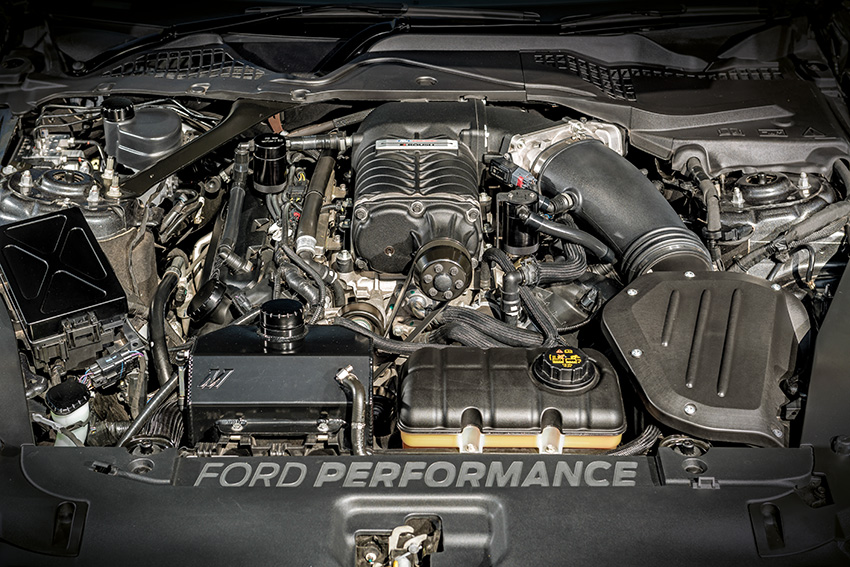
Exhaust Manifold
The biggest gains are found by swapping the headers. Interestingly, the US-market cars made a little more power from the factory than UK cars (416 horsepower over 410 horsepower). This was due to the right-hand conversion resulting in a redesigned, slightly-more restrictive exhaust manifold, and therefore less top-end power.
Not that it matters, in the pursuit of performance you’ll be binning the stock stuff regardless of which side the steering wheel is! Again, there are several options but the long-tube headers from Kooks are widely regarded as some of the best on the market. These are available with 1-3/4in-diameter tubes (perfect for NA tuning) or larger 1-7/8in tubes (said to be ideal for big-power S550s running over 600 horsepower). Expect to pay around $1900-$2500 for a pair of smaller-diameter headers with high-flow sports cats. You can pay as much as $3000 for the larger headers with higher-quality 300-cell cats. Or, for race cars even larger 2.0in headers are available.
Remapping
To make the most of all that extra breathing, a software upgrade completes the holy trinity of air filter, exhaust and remap.
Choose a reputable tuner and you’ll see around 480-to-500 horsepower. You can nudge that closer to 500 horsepower with upgrades to the throttle body and intake manifold, but at this point, the cost-per-horsepower-gained becomes difficult to justify. Especially when you can literally bolt on another 200-to-300 horsepower in the shape of a supercharger.
Or you could just drop in a complete crate engine from Ford Performance. The top-dog V8 motor is the 5.2-liter Aluminator XS. Up to 580 horsepower at a screaming 7800rpm comes thanks to forged conrods, pistons and crank, CNC-ported GT350 cylinder heads, custom cams, and Cobra Jet intake and throttle. Yours for around $21,000.
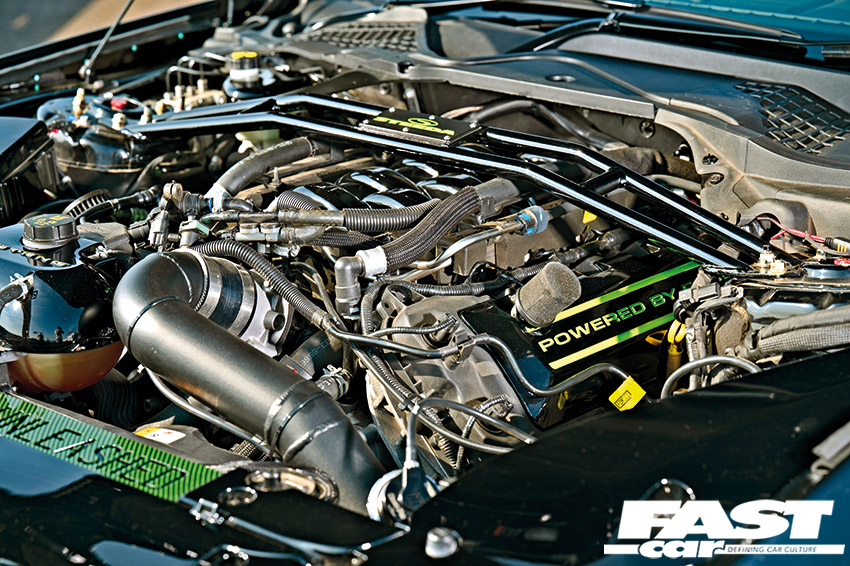
Ford Mustang S550 Forced Induction Tuning
Supercharging
It’s easier, and cheaper, to get big numbers from the S550 Mustang by adding boost. Supercharger upgrades are by far the simplest solution, and complete kits are available that bolt straight on. Even controlling the ECU has been taken care of with most systems coming with recalibrated software solutions to suit.
There are two main supercharger configurations to choose from: twin-screw or centrifugal. In both cases, comprehensive bolt-on kits are available and include pipework, intercooler and ECU tunes. We’ve featured plenty of supercharged Mustangs for you to ogle over.
Centrifugal kits from the likes of Procharger and Vortech have a more ‘aftermarket’ approach, whereas most OEMs tend to go for the twin-screw design. And there are lots of twin-screw options out there from Roush, Edelbrock, Whipple and even Ford Performance.
The centrifugal kits tend to be a bit cheaper and not as aggressive lower down in the rev range. Twin-screw kits give more instant throttle response, offer a bit more tuneability and are usually a bit more expensive.
Both give truly epic gains: on a completely standard engine, 700 horsepower is easily achievable. With uprated oil pump gears and cam sprockets, you can up the boost alongside some bigger injectors and have 850 horsepower under your right foot. Kits typically start at around $8000.
Turbocharging
But supercharging isn’t the only way to boost your Mustang. Complete turbo kits are also available and include (almost) everything you need for installation. Many of these kits are designed for left-hand-drive cars though, so fitting to a UK car can take some work.
As turbos are driven by exhaust gases rather than a belt-driven supercharger, they can be better tuned to give a higher or lower boost at any given revs. On a standard Coyote engine, there’s nothing between the supercharger kits and turbo kits, in terms of price and indeed power. Have a nosey at the UK’s first turbocharged Mustang!
But turbochargers offer almost limitless power when you start taking the engine apart and fitting stronger internals. We’ve been told that 1500 horsepower isn’t all that difficult with a built engine, bigger turbos and some fueling upgrades, and MMR has already built a Coyote turbo thumping out a quite ridiculous 2138 horsepower!
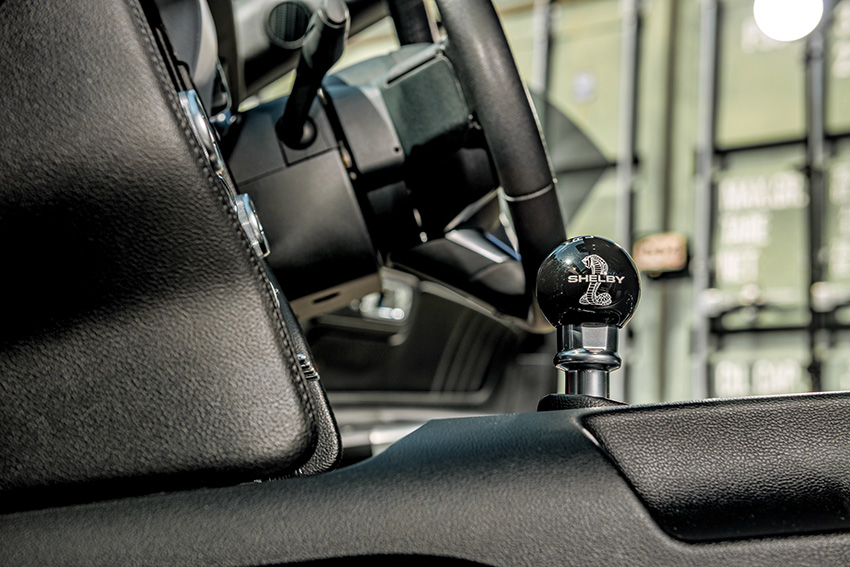
Ford Mustang S550 Transmission Tuning
If you’ve bought an S550 with automatic transmission – especially the later ten-speed 2018-on model with the 10R80 transmission – then well done: sit back and relax; your work here is already done.
But many Mustang owners opted for the more involving manual transmission, and unfortunately, the Getrag MT-82 is not without its problems. The later MT-82-D4 (D4 for direct fourth) from 2018-onwards used a dual-mass flywheel, twin disc clutch, larger synchros, and different tooth geometry. It’s better but didn’t cure all the issues.
According to specialist CJ Pony Parts, some simple upgrades can help overcome the main issues. For starters, an uprated clutch kit can help with the high-speed lockout issue the MT-82 suffers from, while a short-throw shifter improves feel, and shifter support brackets add rigidity to prevent missing shifts. One caveat, though: the MT-82 can be finicky, so over-tightening bolts or a slight misalignment of things such as the reverse lock-out can cause issues. Installed correctly, though, they are fine.
Steeda warns against fitting stiffer diff bushes on a road car; the diffs can be noisy from the factory, and a stiffer bush can amplify this into the cabin. They are great for drag cars, though. And if you do spend time on the strip, invest in a set of hardcore diff bolts to prevent the stubby original bolts from shearing and your diff falling out.
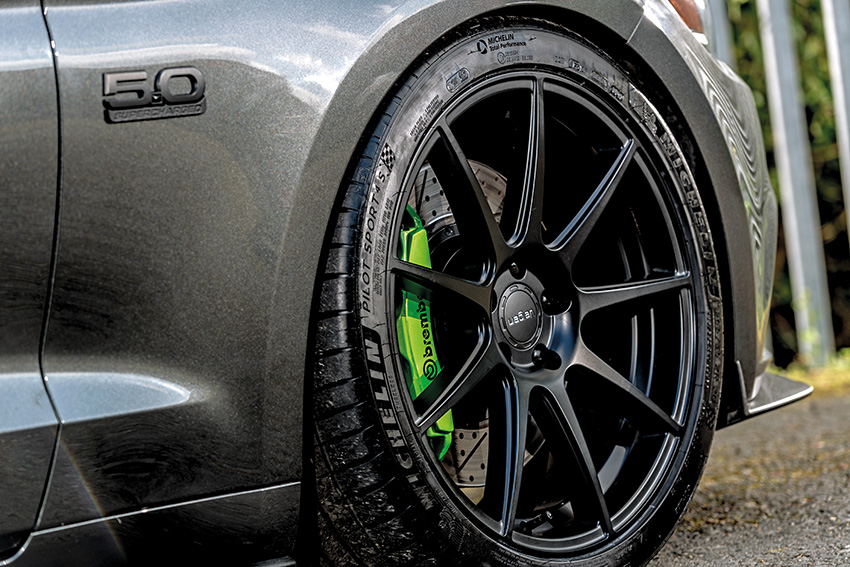
Ford Mustang S550 Suspension Tuning
Add a few upgrades in the right places and the S550 will carve through corners as well as, if not better than, some of its more established German rivals.
The first thing to do is sort the alignment. The S550’s rear subframe has large bolt-holes to make assembly in the factory easier and faster, but this also means the subframe location isn’t very precise. Steeda says it can be as much as 12mm out, meaning the rear subframe isn’t actually in the center of the car.
That’s why one of the best upgrades you can make to any S550 – tuned or standard – is to fit a set of IRS (independent rear suspension) alignment bushes. These are basically sleeves for those larger bolt holes, which will centralize the subframe.
The alignment bushes are available separately but work best when combined with Steeda’s subframe bushing support system in the IRS base pack. These aluminum inserts work with the OE rubber bushes, so don’t increase NVH but do reduce the amount of movement in the stock bushes.
With that lot in place, a four-wheel alignment session will make sure all four wheels are pointing where they should. Steeda recommends the following for a fast road S550: front camber, -1.2deg; front caster, 7.5deg; front toe, 0.2deg; rear camber, 1.6deg; and rear toe, 0.2deg.
Lowering Springs or Coilovers?
Lowering springs will help get the car sitting closer to the ground and offer improvements to body roll too; there are several options available from different suppliers, including linear, progressive, and dual-rate types. Which you choose will depend on how you use the car; speak to your tuner to discuss in more detail.
For most owners, a good set of springs and dampers will be more than up to the job but if you like to take your Mustang on track a lot, or want almost endless adjustability, then a good set of coilovers will really allow you to fine-tune the damping and ride-height settings.
Instead, a street car will see money more wisely spent on upgrading suspension bushes, braces and arms. Polyurethane bushes will help reduce unwanted movement, but on the S550, the rubber bush itself is often not the cause for concern; it’s the bar, link, or arm the bush is fitted to that’s the issue. The standard rear vertical links, for example, are made from pressed steel and are susceptible to flexing under load. So too are the rear toe links.
Steeda, BMR and Hardrace all offer bolt-on upgrades that will eliminate the problem. As a bonus, they are adjustable too.
Anti-roll bars
It’s also worth looking at the anti-roll bars. There are options available from all the well-known names including Steeda, Ford Performance and Eibach, and they all work in a similar way – beef up the standard roll bar with a stronger, stiffer design to further resist any roll and improve longevity compared to the stock part, and most are adjustable too.
There’s almost as much scope in S550 chassis tuning as there is engine tuning, and you can build on these mods with more bracing and strengthening, more adjustment, and even a lightweight race-spec front crossmember, all available as bolt-on upgrades.
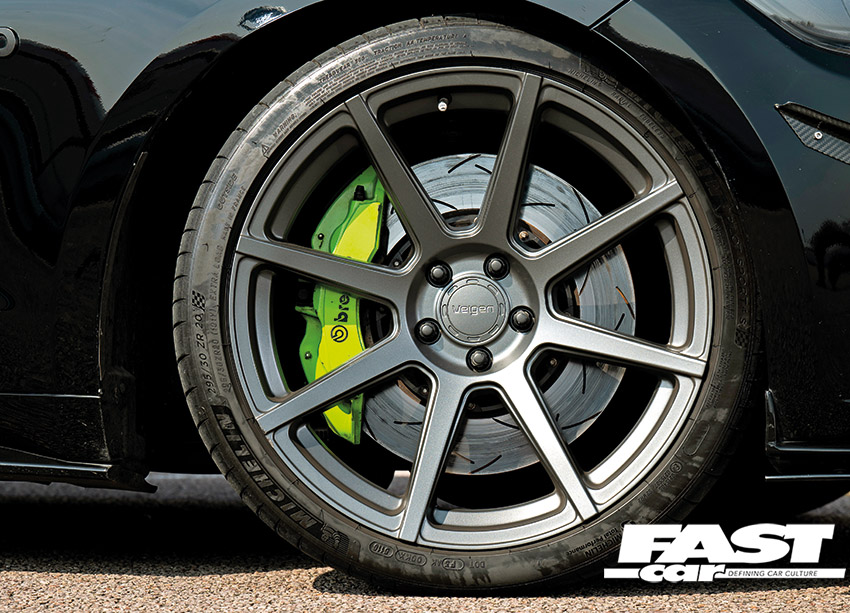
Ford Mustang Brakes
Most GT’s (including all British Mustang GTs) came with Ford’s Performance Pack 1 fitted. If not, this is the first step in upgrading the brakes, as the Performance Pack added whopping Brembo six-pot front calipers and 380x34mm discs, plus 330x25mm ventilated rear discs with floating calipers. They’re more than enough for most users, but some track-day and/or big-power owners have swapped discs for lighter two-piece items and fitted more aggressive pads. They will cope with most things you can throw at them.
But, if you want the ultimate, look to the Ford Performance catalogue, and specifically the Shelby GT350R brake upgrade. This kit includes Brembo six-pot front calipers with massive 15.5in (394mm) rotors, as well as Brembo four-pot rears with 14.9in (378mm) discs, parking brake assembly, street-spec pads, and everything to fit. They’re not badly priced at $4200 for the whole kit, either.
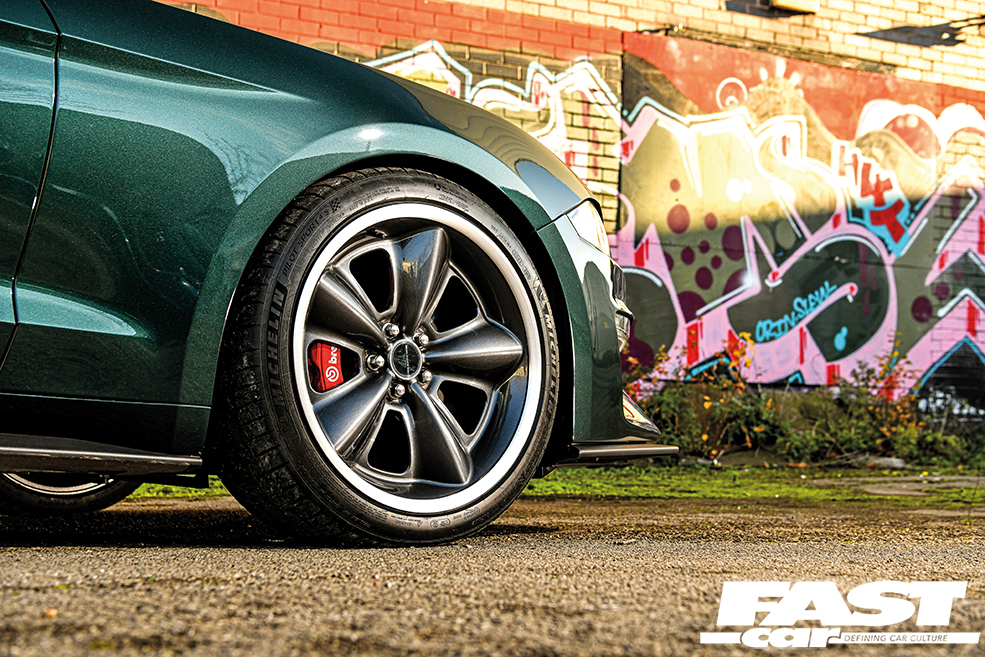
Ford Mustang S550 Wheels & Tire Upgrades
The key to improving performance here is weight; or removing as much of it as you can. The stock 19in alloys are heavy, and you can find significant performance gains by swapping to a lightweight option. The stock GT wheels weigh around 15kg (33lb) each, whereas Velgen’s flow-formed VF5 weighs just 11.3kg (25lb). No wonder it’s a popular upgrade. Of course, there are plenty of options available from specialists.
As for tires, stick to premium brands and high-performance ranges. There is no room for compromise with a big power ‘Stang.
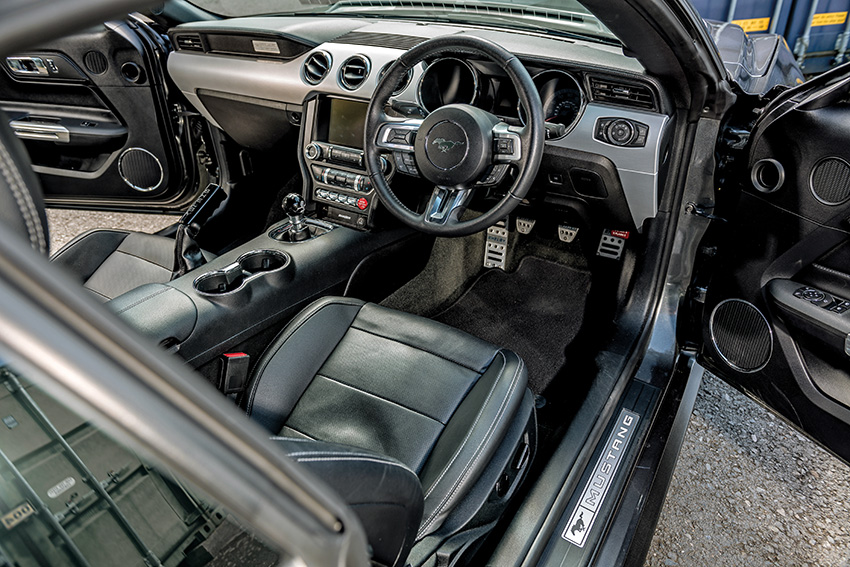
Ford Mustang S550 Interior Upgrades
The Mustang GT came well-equipped as standard – unlike some of the lesser-spec models. It’s all about personal taste when it comes to interior dress-up; the stock seats are ideal for a comfy GT car, but for more spirited use on the street or track a pair of bucket seats offer more stability.
The car’s infotainment system is good, but there are better aftermarket options on the market now. Plus, while the standard car’s audio system suffices, those who love their audio as much as their V8s will want a little speaker upgrade to deliver more performance.
Elsewhere in the cabin it again boils down to personal taste. some opt for a simpler steering wheel with a little more thickness to the rim. Others swap out gear levers for purely aesthetic reasons, while others start removing unwanted plastics to help save weight.
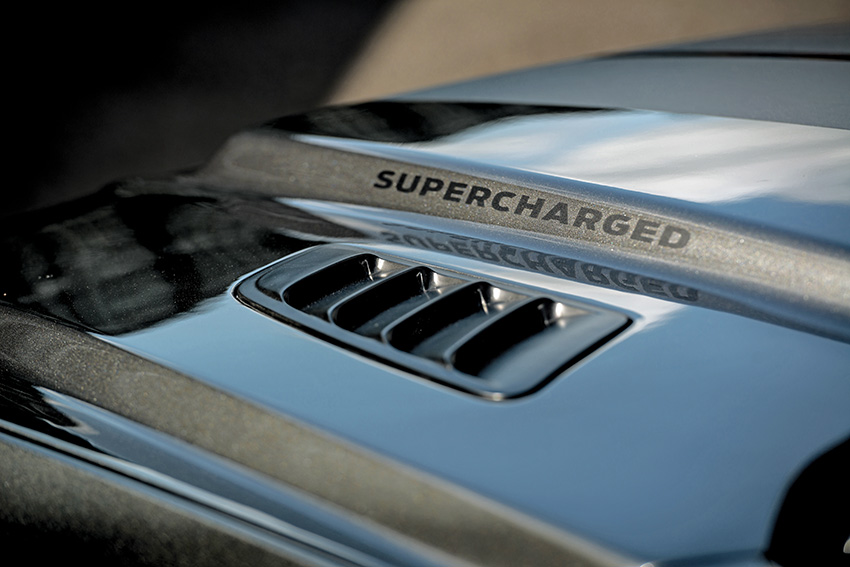
Ford Mustang styling upgrades
You can get wide body kits and huge rear wings for the S550, but the already aggressive Mustang really doesn’t need much help in the getting-noticed department. Instead, subtle touches and the OEM-plus approach tend to get an appreciative nod from those in the know.
Shelby-tuned cars came with a selection of aesthetic upgrades, and plenty of OEM-style improvements are available, such as replacement boot lids, side scoops, and various grille upgrades. One of the best-looking styling extras in our book is the carbon-fiber GT350R-style rear spoiler – it’s not cheap, but it is beautiful.
Of course, for those who want to take it to the extreme, there are numerous wide-arch kits to choose from too – just factor in the labor costs to fit and paint the kit will add to overall expense.
Words: Jamie & Ben Birch. Photos: AS Design.

